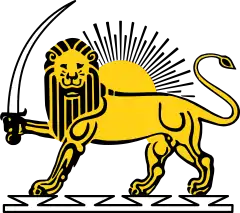Pahlavi dynasty
The Imperial State of Iran (Persian: کشور شاهنشاهی ایران, romanized: Kešvar-e Šâhanšâhi-ye Irân),[3] also known as the Imperial State of Persia from 1925 to 1935, was a sovereign state in Western Asia which was bordered by Turkey and Iraq to the west, the Soviet Union to the north, Afghanistan and Pakistan to the east and shared a maritime border with Oman toward the south. With a population of 37 million in 1979, Tehran served as its capital city.
Imperial State of Irana کشور شاهنشاهی ایران Kešvar-e Šâhanšâhi-ye Irân | |||||||||
|---|---|---|---|---|---|---|---|---|---|
| 1925–1979 | |||||||||
.svg.png.webp) | |||||||||
.svg.png.webp) Location of Iran on the globe (current geopolitical boundaries, not at the time of the Imperial State of Iran). | |||||||||
| Capital and largest city | Tehran | ||||||||
| Official languages | Persian | ||||||||
| Religion | Shia Islam[3] | ||||||||
| Demonym(s) | Persian (until 1935) Iranian (from 1935) | ||||||||
| Government |
| ||||||||
| Shah | |||||||||
• 1925–1941 (first) | Reza Shah Pahlavi | ||||||||
• 1941–1979 (last, longest) | Mohammad Reza Pahlavi | ||||||||
| Prime minister | |||||||||
• 1925–1926 (first) | Mohammad-Ali Foroughi | ||||||||
• 1979 (last) | Shapour Bakhtiar | ||||||||
| Legislature | Deliberative assembly | ||||||||
| Senate (1949–79) | |||||||||
| National Consultative Assembly | |||||||||
| Historical era | 20th century | ||||||||
• Constituent Assembly voted formation of Pahlavi dynasty | 15 December 1925 | ||||||||
| 25 August – 17 September 1941 | |||||||||
| 24 October 1945 | |||||||||
| 19 August 1953 | |||||||||
| 26 January 1963 | |||||||||
| 11 February 1979 | |||||||||
| 31 March 1979 | |||||||||
| Area | |||||||||
| 1979 | 1,648,195 km2 (636,372 sq mi) | ||||||||
| Population | |||||||||
• 1955 | 19,293,999 | ||||||||
• 1965 | 24,955,115 | ||||||||
• 1979 | 37,252,629 | ||||||||
| GDP (PPP) | 1972 estimate | ||||||||
• Per capita | $571[3] | ||||||||
| Currency | Rial[3] | ||||||||
| ISO 3166 code | IR | ||||||||
| |||||||||
| |||||||||
| Pahlavi | |
|---|---|
 | |
| Founded | 15 December 1925 |
| Founder | Reza Shah |
| Current head | Reza Pahlavi |
| Final ruler | Mohammad Reza Pahlavi |
| Titles | |
| Deposition | 11 February 1979 |
It was ruled by the Pahlavi dynasty, the last ruling house of Iran, from 1925 until 1979, when the Persian monarchy was overthrown and abolished as a result of the Iranian Revolution. The dynasty was founded by Reza Shah Pahlavi in 1925, a former brigadier-general of the Persian Cossack Brigade, whose reign lasted until 1941, when he was forced to abdicate by the Allies after the Anglo-Soviet invasion of Iran. He was succeeded by his son, Mohammad Reza Pahlavi, the last Shah of Iran.
The Pahlavis came to power after Ahmad Shah Qajar, the last Qajar ruler of Iran, proved unable to stop British and Soviet encroachment on Iranian sovereignty, had his position extremely weakened by a military coup, and was removed from power by the parliament while in France. The Iranian parliament, known as the Majlis, convening as a Constituent Assembly on 12 December 1925, deposed the young Ahmad Shah Qajar, and declared Reza Khan the new King (Shah) of Imperial State of Persia. In 1935, Reza Shah asked foreign delegates to use the endonym Iran in formal correspondence and the official name the Imperial State of Iran was adopted.
Following the coup d'état in 1953 supported by the United Kingdom and the United States, Mohammad Reza Pahlavi's rule became more autocratic and was aligned with the Western Bloc during the Cold War, although he enacted a series of economic and social reforms known as the White Revolution. By 1978 the Shah faced growing public discontent and popular rebellion, and the second Pahlavi went into exile with his family in January 1979, sparking a series of events that quickly led to the end of the state and the beginning of the Islamic Republic of Iran on 11 February 1979.
Origins
The Pahlavi dynasty is an Iranian royal dynasty of Mazandarani ethnicity. The Pahlavi dynasty originated in Iran’s Mazandaran province.[4][5][6][7] In 1878 Reza Shah Pahlavi was born at the village of Alasht in Savadkuh County, Mazandaran Province. His parents were Abbas Ali Khan and Noushafarin Ayromlou.[8][9] His mother was a Muslim immigrant from Georgia (then part of the Russian Empire),[10][11] whose family had emigrated to mainland Qajar Iran after Iran was forced to cede all of its territories in the Caucasus following the Russo-Persian Wars several decades prior to Reza Shah's birth.[12] His father was a Mazandarani, commissioned in the 7th Savadkuh Regiment, and served in the Anglo-Persian War in 1856.
Establishment
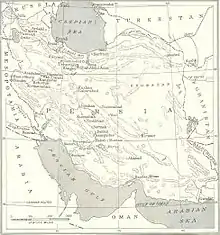
In 1925, Reza Khan, a former Brigadier-General of the Persian Cossack Brigade, deposed the Qajar dynasty and declared himself king (shah), adopting the dynastic name of Pahlavi, which recalls the Middle Persian language of the Sasanian Empire.[13] By the mid-1930s, Rezā Shāh's strong secular rule caused dissatisfaction among some groups, particularly the clergy, who opposed his reforms, but the middle and upper-middle class of Iran liked what Rezā Shāh did. In 1935, Rezā Shāh issued a decree asking foreign delegates to use the term Iran in formal correspondence, in accordance with the fact that "Persia" was a term used by Western peoples for the country called "Iran" in Persian. His successor, Mohammad Reza Pahlavi, announced in 1959 that both Persia and Iran were acceptable and could be used interchangeably.
Reza Shah tried to avoid involvement with the UK and the Soviet Union. Though many of his development projects required foreign technical expertise, he avoided awarding contracts to British and Soviet companies because of dissatisfaction during the Qajar Dynasty between Persia, the UK, and the Soviets. Although the UK, through its ownership of the Anglo-Iranian Oil Company, controlled all of Iran's oil resources, Rezā Shāh preferred to obtain technical assistance from Germany, France, Italy and other European countries. This created problems for Iran after 1939, when Germany and Britain became enemies in World War II. Reza Shah proclaimed Iran as a neutral country, but Britain insisted that German engineers and technicians in Iran were spies with missions to sabotage British oil facilities in southwestern Iran. Britain demanded that Iran expel all German citizens, but Rezā Shāh refused, claiming this would adversely affect his development projects.
World War II
Part of a series on the |
|---|
| History of Iran |
 |
|
Timeline |
Iran claimed to be a neutral country during the opening years of World War II. In April, 1941, the war reached Iran's borders when Rashid Ali, with assistance from Germany and Italy, launched the 1941 Iraqi coup d'état, sparking the Anglo-Iraqi War of May, 1941. Germany and Italy quickly sent the pro-Axis forces in Iraq military aid from Syria but during the period from May to July the British and their allies defeated the pro-Axis forces in Iraq and later Syria and Lebanon.
In June 1941, Nazi Germany broke the Molotov–Ribbentrop Pact and invaded the Soviet Union, Iran's northern neighbor. The Soviets quickly allied themselves with the Allied countries and in July and August, 1941 the British demanded that the Iranian government expel all Germans from Iran. Reza Shah refused to expel the Germans and on 25 August 1941, the British and Soviets launched a surprise invasion and Reza Shah's government quickly surrendered after less than a week of fighting.[14] The invasion's strategic purpose was to secure a supply line to the USSR (later named the Persian Corridor), secure the oil fields and Abadan Refinery (of the UK-owned Anglo-Iranian Oil Company), and limit German influence in Iran. Following the invasion, on 16 September 1941 Reza Shah abdicated and was replaced by Mohammad Reza Pahlavi, his 21 year old son.[15][16][17]

During the rest of World War II, Iran became a major conduit for British and American aid to the Soviet Union and an avenue through which over 120,000 Polish refugees and Polish Armed Forces fled the Axis advance.[18] At the 1943 Tehran Conference, the Allied "Big Three"—Joseph Stalin, Franklin D. Roosevelt, and Winston Churchill—issued the Tehran Declaration to guarantee the post-war independence and boundaries of Iran.
On 13 September 1943 the Allies reassured the Iranians that all foreign troops would leave by 2 March 1946.[19] At the time, the Tudeh Party of Iran, a communist party that was already influential and had parliamentary representation, was becoming increasingly militant, especially in the North. This promoted actions from the side of the government, including attempts of the Iranian armed forces to restore order in the Northern provinces. While the Tudeh headquarters in Tehran were occupied and the Isfahan branch crushed, the Soviet troops present in the Northern parts of the country prevented the Iranian forces from entering. Thus, by November 1945 Azerbaijan had become an autonomous state helped by the Tudeh party.[19][20] This pro-Soviet nominal-government fell by November 1946, after support from the United States for Iran to reclaim the regions that declared themselves autonomous.
At the end of the war, Soviet troops remained in Iran and established two puppet states in north-western Iran, namely the People's Government of Azerbaijan and the Republic of Mahabad. This led to the Iran crisis of 1946, one of the first confrontations of the Cold War, which ended after oil concessions were promised to the USSR and Soviet forces withdrew from Iran proper in May 1946. The two puppet states were soon overthrown and the oil concessions were later revoked.[21][22]
Cold War
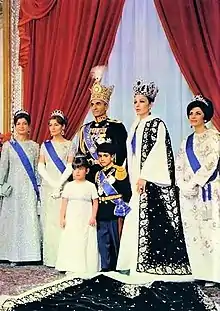
Mohammad Reza Pahlavi replaced his father on the throne on 16 September 1941. He wanted to continue the reform policies of his father, but a contest for control of the government soon erupted between him and an older professional politician, the nationalistic Mohammad Mosaddegh.
In 1951, the Majlis (the Parliament of Iran) named Mohammad Mossadegh as new prime minister by a vote of 79–12, who shortly after nationalized the British-owned oil industry (see Abadan Crisis). Mossadegh was opposed by the Shah who feared a resulting oil embargo imposed by the West would leave Iran in economic ruin. The Shah fled Iran but returned when the United Kingdom and the United States staged a coup against Mossadegh in August 1953 (see Operation Ajax). Mossadegh was then arrested by pro-Shah army forces.
Major plans to build Iran's infrastructure were undertaken, a new middle class began flourishing and in less than two decades Iran became the indisputable major economic and military power of the Middle East.
Collapse of the dynasty
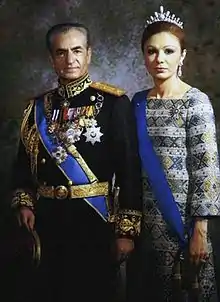
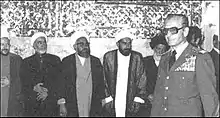
The Shah's government suppressed its opponents with the help of Iran's security and intelligence secret police, SAVAK. Such opponents included leftists and Islamists.
By the mid-1970s, relying on increased oil revenues, Mohammad Reza began a series of even more ambitious and bolder plans for the progress of his country and the march toward the "White Revolution". But his socioeconomic advances increasingly irritated the clergy. Islamic leaders, particularly the exiled cleric Ayatollah Ruhollah Khomeini, were able to focus this discontent with an ideology tied to Islamic principles that called for the overthrow of the Shah and the return to Islamic traditions, called the Islamic revolution. The Pahlavi regime collapsed following widespread uprisings in 1978 and 1979. The Islamic Revolution dissolved the SAVAK and replaced it with the SAVAMA. It was run after the revolution, according to U.S. sources and Iranian exile sources in the US and in Paris, by Gen. Hossein Fardoust, who was deputy chief of SAVAK under Mohammad Reza's reign, and a friend from boyhood of the deposed monarch.
Mohammad Reza fled the country, seeking medical treatment in Egypt, Mexico, the United States, and Panama, and finally resettled with his family in Egypt as a guest of Anwar Sadat. On his death, his son Crown Prince Reza Pahlavi succeeded him in absentia as heir apparent to the Pahlavi dynasty. Reza Pahlavi and his wife live in the United States in Potomac, Maryland, with three daughters.[23]
Legacy
Under the Qajar dynasty the Persian character of Iran was not very explicit. Although the country was referred to as Persia by westerners, and the dominant language in court and administration was Persian the dichotomy between pure Persian and Turkic elements had remained obvious until 1925. The Pahlavi rule was instrumental in Iran's nationalisation in line with Persian culture and language which, among other ways, was achieved through the official ban on the use minority languages such as Azerbaijani and successful suppression of separatist movements. Reza Pahlavi is credited for reunification of Iran under a powerful central government. The use of minority languages in schools and newspapers was not tolerated. The succeeding regime – the Islamic Republic of Iran – has adopted a more inclusive approach in relation to the use of ethnic minorities and their language, however the issues as to Azeris, the Iran's largest ethnic minority, remain and pose considerable challenges for the unity and territorial integrity of Iran.[24]
Pahlavi Shahs of Iran
| Name | Portrait | Family relations | Lifespan | Entered office | Left office | |
|---|---|---|---|---|---|---|
| Shahs of Iran | ||||||
| 1 | Reza Shah | 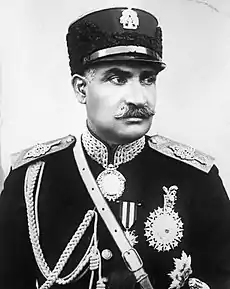 | Son of Abbas Ali | 1878–1944 | 15 December 1925 | 16 September 1941 |
| 2 | Mohammad Reza Pahlavi | 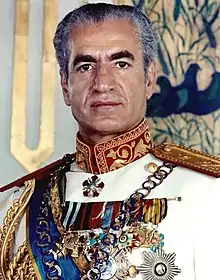 | Son of Reza Shah | 1919–1980 | 16 September 1941 | 11 February 1979 |
| In pretence | ||||||
| 1 | Mohammad Reza Pahlavi |  | Son of Reza Shah | 1919–1980 | 11 February 1979 | 27 July 1980 |
| — | Farah Pahlavi (Regent in pretence)[25] |  | Wife of Mohammad Reza Pahlavi | 1938– | 27 July 1980[25] | 31 October 1980[25] |
| 2 | Reza Pahlavi | 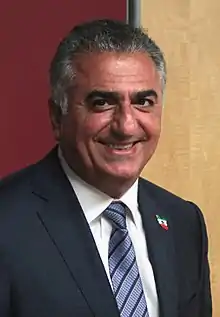 | Son of Mohammad Reza Pahlavi | 1960– | 31 October 1980[25] | Incumbent |
Use of titles
- Shâh: Emperor, followed by Shâhanshâh of Iran, with style His Imperial Majesty
- Shahbânu: Shahbânu or Empress, followed by first name, followed by "of Iran", with style Her Imperial Majesty
- Valiahd: Crown Prince of Iran, with style His Imperial Highness
- Younger sons: Prince (Shâhpūr, or King's Son), followed by first name and surname (Pahlavi), and style His Imperial Highness.
- Daughters: Princess (Shâhdokht, or King's Daughter), followed by first name and surname (Pahlavi), and style Her Imperial Highness.
- Children of the monarch's daughter/s use another version of Prince (Vâlâ Gohar, "of superior essence") or Princess (Vâlâ Gohari), which indicate descent in the second generation through the female line, and use the styles His Highness or Her Highness. This is then followed by first name and father's surname, whether he was royal or a commoner. However, the children by the last Shah's sister Fatemeh, who married an American businessman as her first husband, are surnamed Pahlavi Hillyer and do not use any titles.
Human rights
During The Imperial state of Iran — Reza Shah Pahlavi and his son Mohammad Reza Shah Pahlavi — employed secret police, torture, and executions to stifle political dissent. The Pahlavi dynasty has sometimes been described as a "royal dictatorship", or "one man rule". According to one history of the use of torture by the state in Iran, abuse of prisoners varied at times during the Pahlavi reign.
Corruption
Manouchehr Ganji led an anti-corruption study group which submitted at least 30 reports in 13 years detailing corruption of high-ranking officials and the royal circle, but Shah called the reports "false rumors and fabrications". Parviz Sabeti, a high-ranking official of SAVAK believed that the one important reason for successful opposition to the regime was the allegations of corruption.[26]
See also
- Abdolhossein Teymourtash
- Abdul Reza Pahlavi
- Ey Iran
- Fajr decade
- Gholamreza Pahlavi
- Kamal Habibollahi
- Kashf-e hijab
- Norman Schwarzkopf, Sr.
- Persian Corridor
- Imperial Anthem of Iran
- Tehran Conference ("Eureka")
- Trans-Iranian Railway
- List of Shi'a Muslims dynasties
Notes and references
- "Flags of the World: Iranian Empire (Pahlavi Dynasty, 1964–1979)". Retrieved 10 November 2010.
- Whitney Smith (1980), Flags and Arms across the World, McGraw-Hill, ISBN 978-0-07-059094-6
- "IRAN: Keshvaré Shahanshahiyé Irân", The Statesman's Year-Book 1978–79, Springer, 2016, pp. 674–682, ISBN 9780230271074
- کوروش, نوروز مرادی; نوری, مصطفی (1388). "سندی نویافته از نیای رضاشاه" (PDF). پیام بهارستان. د۲،س ۱،ش۴.
- معتضد, خسرو (1387). تاج های زنانه (چاپ اول ed.). تهران: نشر البرز. pp. 46 47 48 49 50 51 جلد اول. ISBN 9789644425974.
- نیازمند, رضا (1387). رضاشاه از تولد تا سلطنت (چاپ ششم ed.). تهران: حکایت قلم نوین. pp. 15 16 21 22 23 24 25 26 27 28 29 30 31 32 33 39 40 43 44 45. ISBN 9645925460.
- زیباکلام, صادق (1398). رضاشاه (اول ed.). تهران: روزنه،لندن:اچ انداس. pp. 61, 62. ISBN 9781780837628.
- Gholam Reza Afkhami (27 October 2008). The Life and Times of the Shah. University of California Press. p. 4. ISBN 978-0-520-25328-5. Retrieved 2 November 2012.
- Zirinsky, Michael P. (1992). "Imperial power and dictatorship: Britain and the rise of Reza Shah, 1921-1926". International Journal of Middle East Studies. 24 (4): 639–663. doi:10.1017/s0020743800022388. Retrieved 2 November 2012.
- Afkhami, Gholam Reza (2009). The Life and Times of the Shah. University of California Press. p. 4.
(..) His mother, who was of Georgian origin, died not long after, leaving Reza in her brother's care in Tehran. (...).
- GholamAli Haddad Adel; et al. (2012). The Pahlavi Dynasty: An Entry from Encyclopaedia of the World of Islam. EWI Press. p. 3.
(...) His mother, Nush Afarin, was a Georgian Muslim immigrant (...).
- Homa Katouzian. "State and Society in Iran: The Eclipse of the Qajars and the Emergence of the Pahlavis" I.B.Tauris, 2006. ISBN 978-1845112721 p 269
- Ansari, Ali M. (2003). Modern Iran Since 1921: The Pahlavis and After. Longman. p. 36. ISBN 978-0-582-35685-6. Retrieved 14 February 2016.
- Glenn E. Curtis, Eric Hooglund; US Government Printing Office (2008). Iran: A Country Study. U.S. Government Printing Office. p. 30. ISBN 978-0-8444-1187-3.
- Farrokh, Kaveh (2011). Iran at War: 1500–1988. ISBN 978-1-78096-221-4.
- David S. Sorenson (2013). An Introduction to the Modern Middle East: History, Religion, Political Economy, Politics. Westview Press. p. 206. ISBN 978-0-8133-4922-0.
- Iran: Foreign Policy & Government Guide. International Business Publications. 2009. p. 53. ISBN 978-0-7397-9354-1.
- T.H. Vail Motter; United States Army Center of Military History (1952). United States Army in World War II the Middle East Theater the Persian Corridor and Aid to Russia. CMH.
- Jessup, John E. (1989). A Chronology of Conflict and Resolution, 1945–1985. New York: Greenwood Press. ISBN 0-313-24308-5.
- The Iranian Crisis of 1945–1946 and the Spiral Model of International Conflict, by Fred H. Lawson in International Journal of Middle East Studies p.9
- Louise Fawcett, "Revisiting the Iranian Crisis of 1946: How Much More Do We Know?." Iranian Studies 47#3 (2014): 379–399.
- Gary R. Hess, "the Iranian Crisis of 1945–46 and the Cold War." Political Science Quarterly 89#1 (1974): 117–146. online
- Michael Coleman (30 July 2013). "Son of Iran's Last Shah: 'I Am My Own Man'". The Washington Diplomat. Archived from the original on 22 September 2013. Retrieved 21 September 2013.
- Tohidi, Nayereh. "Iran: regionalism, ethnicity and democracy". Archived from the original on 14 July 2013. Retrieved 1 August 2013.
- "Former Iranian Crown Prince Reza Pahlavi will proclaim himself the new shah of Iran", United Press International, 17 October 1980, archived from the original on 28 January 2019, retrieved 25 January 2019,
His Imperial Highness Reza Pahlavi, Crown Prince of Iran, will reach his constitutional majority on the 9th of Aban, 1359 (October 31, 1980). On this date, and in conformity with the Iranian Constitution, the regency of Her Imperial Majesty Farah Pahlavi, Shahbanou of Iran, will come to an end and His Imperial Highness, who on this occasion will send a message to the people of Iran, will succeed his father, His Imperial Majesty Mohammed Reza Shah Pahlavi, deceased in Cairo on Mordad 5, 1359 (July 27, 1980).
- Ganji, p. 8-9
Further reading
- The Fall of Heaven: The Pahlavis and the Final Days of Imperial Iran, by Andrew Scott Cooper (Henry Holt and Company, 2016) ISBN 9780805098983.
- What Really Happened to the Shah of Iran, Payvand News, 10 March 2006.
External links
| Wikimedia Commons has media related to Pahlavi. |
| Wikiquote has quotations related to: Imperial State of Iran |
- Pahlavi dynasty at Iran Chamber
- The Pahlavi Dynasty coins and insignia
— Royal house — House of Pahlavī Founding year: 1925 Deposition: 1979 | ||
| Preceded by House of Qâjâr |
Ruling house of Iran 15 December 1925 – 11 February 1979 |
Vacant |
